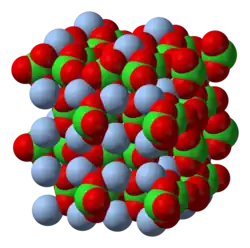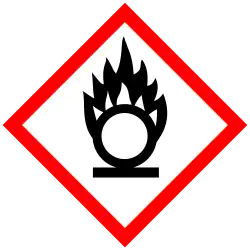Silver chlorate
 | |
| Names | |
|---|---|
| IUPAC name
Silver(I) chlorate
| |
| Systematic IUPAC name
Silver(I) chlorate(V) | |
| Other names
Argentous chlorate[1]
| |
| Identifiers | |
3D model (JSmol)
|
|
| ChemSpider | |
| ECHA InfoCard | 100.029.122 |
| EC Number |
|
PubChem CID
|
|
| UNII | |
CompTox Dashboard (EPA)
|
|
| |
| |
| Properties | |
| AgClO3 | |
| Molar mass | 191.32 g·mol−1 |
| Appearance | white crystals |
| Density |
|
| Melting point | 230 °C (446 °F; 503 K)[2] |
| Boiling point | 270 °C (518 °F; 543 K)[2] (decomposes) |
| slightly soluble | |
| Solubility in alcohols | soluble |
| Structure | |
| tetragonal or cubic | |
| Hazards[1] | |
| Occupational safety and health (OHS/OSH): | |
Main hazards
|
Oxidizing solids (Category 2), H272 |
Inhalation hazards
|
Specific target organ toxicity - single exposure (Category 3), Respiratory system, H335 |
Eye hazards
|
Eye irritation (Category 2A), H319 |
Skin hazards
|
Skin irritation (Category 2), H315 |
| GHS labelling: | |
 
| |
| Danger | |
| H272, H315, H319, H335 | |
| P210, P220, P221, P261, P264, P271, P280, P302+P352, P304+P340+P312, P305+P351+P338, P332+P313, P337+P313, P362, P370+P378, P403+P233, P405, P501 | |
| NFPA 704 (fire diamond) | |
Threshold limit value (TLV)
|
0.01 mg/m3 (TWA) |
| NIOSH (US health exposure limits): | |
PEL (Permissible)
|
0.01 mg/m3 |
REL (Recommended)
|
0.01 mg/m3 |
| Related compounds | |
Other anions
|
|
Other cations
|
|
Except where otherwise noted, data are given for materials in their standard state (at 25 °C [77 °F], 100 kPa).
Infobox references
| |
Silver chlorate is an inorganic compound with molecular formula AgClO3. It exists in two forms: white tetragonal prisms, and cubic crystals.[3][2][4] Like all chlorates, it is water-soluble and an oxidizing agent. As a simple metal salt, it is a common chemical in basic inorganic chemistry experiments. It is light-sensitive, so it must be stored in tightly closed dark-coloured containers.[5]
Silver(I) means silver is in its normal +1 oxidation state.
Production
Silver chlorate is produced by the reaction of silver nitrate with sodium chlorate to produce both silver chlorate and sodium nitrate:[5]
- AgNO3 + NaClO3 → AgClO3 + NaNO3
Alternatively, it may be produced by the bubbling of chlorine gas through a suspension of silver oxide (Ag2O), or by dissolving Ag2O or metallic silver in chloric acid.[2]
Safety
Aside from the potential dangers associated with strong oxidizers, silver chlorate may cause argyria, eye irritation, skin irritation, and temporary respiratory issues.[6]
It also has the potential to explode when heated very rapidly, or if exposed to ammonia which may form the explosive complex triamminesilver chlorate (AgClO3·3NH3).[2]
See also
References
- ^ a b Sigma-Aldrich Co., Silver chlorate. Retrieved on 28 July 2025.
- ^ a b c d e Fedoroff, Basil T.; Sheffield, Oliver E.; Clift, George D.; Reese, Earl F. (1 January 1962). "C". Encyclopedia of Explosives and Related Items: Vol 2 (B (Explosif) through Chloric acid) (PDF). Picatinny Arsenal, NJ: Army Armament Research Development and Engineering Center: Warheads, Energetics, and Combat Support Armaments Research Center. p. C197. Retrieved 28 July 2025.
- ^ Náray-Szabó, St. v.; Pócza, J. (January 1942). "Die Struktur des Silberchlorats AgClO3". Zeitschrift für Kristallographie - Crystalline Materials (in German). 104 (1): 28–38. doi:10.1524/zkri.1942.104.1.28. S2CID 102075872.
- ^ Deshpande, Vilas; Suryanarayana, S V; Frantz, C (December 1982). "Tetragonal to cubic phase transition in silver chlorate". Bulletin of Materials Science. 4 (5): 563–568. doi:10.1007/BF02824963.
- ^ a b Glemser, O.; Sauer, H. (1965). "19. Copper, Silver, Gold". In Brauer, Georg (ed.). Handbook of Preparative Inorganic Chemistry v2 (2nd ed.). New York, USA: Academic Press. p. 1037. ISBN 0-323-16129-4. Retrieved 28 July 2025.
- ^ "SDS: Silver Chlorate". www.sigmaaldrich.com. Sigma-Aldrich. p. 8. Retrieved 28 July 2025.
May cause argyria (a slate-gray or bluish discoloration of the skin and deep tissues due to the deposit of insoluble albuminate of silver)., To the best of our knowledge, the chemical, physical, and toxicological properties have not been thoroughly investigated.
